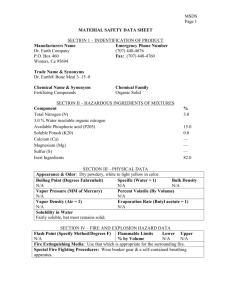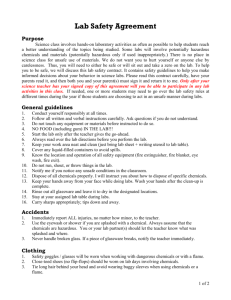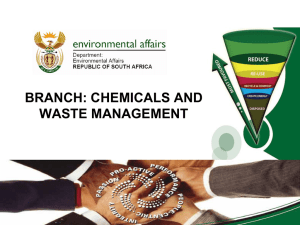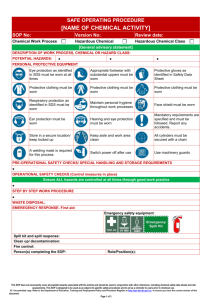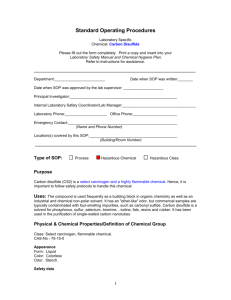UCLA - Environmental Health & Safety
advertisement
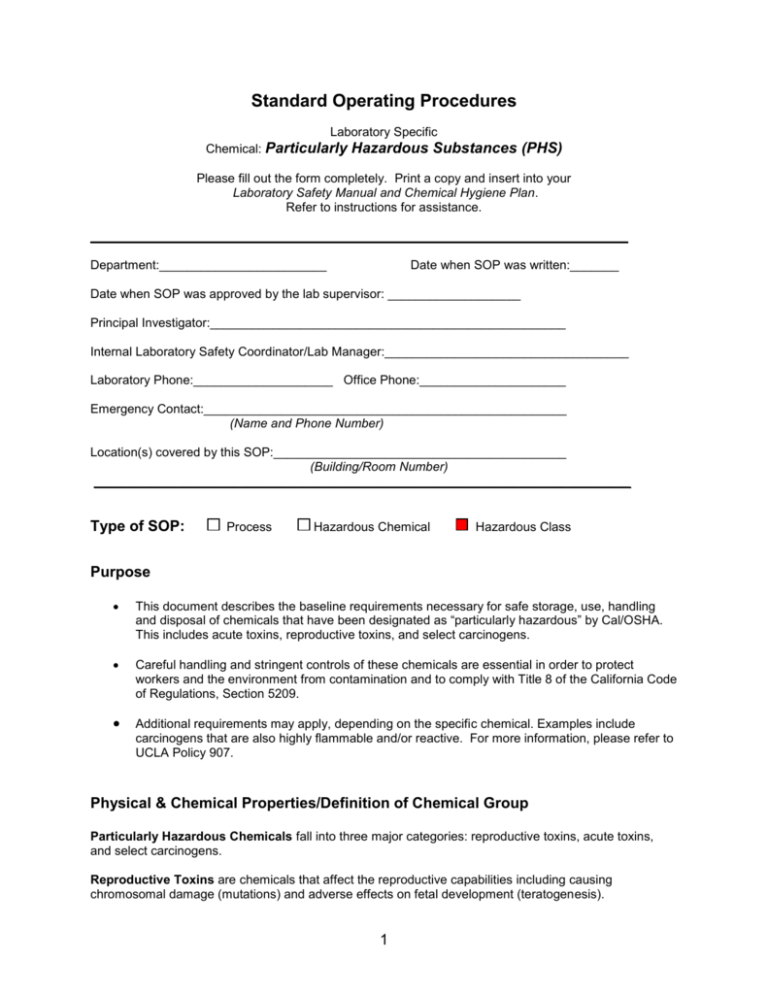
Standard Operating Procedures Laboratory Specific Chemical: Particularly Hazardous Substances (PHS) Please fill out the form completely. Print a copy and insert into your Laboratory Safety Manual and Chemical Hygiene Plan. Refer to instructions for assistance. _____________________________________________________________________________ Department:________________________ Date when SOP was written:_______ Date when SOP was approved by the lab supervisor: ___________________ Principal Investigator:___________________________________________________ Internal Laboratory Safety Coordinator/Lab Manager:___________________________________ Laboratory Phone:____________________ Office Phone:_____________________ Emergency Contact:____________________________________________________ (Name and Phone Number) Location(s) covered by this SOP:__________________________________________ (Building/Room Number) _____________________________________________________________________________ Type of SOP: Process Hazardous Chemical Hazardous Class Purpose This document describes the baseline requirements necessary for safe storage, use, handling and disposal of chemicals that have been designated as “particularly hazardous” by Cal/OSHA. This includes acute toxins, reproductive toxins, and select carcinogens. Careful handling and stringent controls of these chemicals are essential in order to protect workers and the environment from contamination and to comply with Title 8 of the California Code of Regulations, Section 5209. Additional requirements may apply, depending on the specific chemical. Examples include carcinogens that are also highly flammable and/or reactive. For more information, please refer to UCLA Policy 907. Physical & Chemical Properties/Definition of Chemical Group Particularly Hazardous Chemicals fall into three major categories: reproductive toxins, acute toxins, and select carcinogens. Reproductive Toxins are chemicals that affect the reproductive capabilities including causing chromosomal damage (mutations) and adverse effects on fetal development (teratogenesis). 1 For a list of reproductive toxins, please consult the attached list of chemicals known to cause cancer or reproductive toxicity enacted by the EPA Safe Drinking Water and Toxic Enforcement Act of 1986. Acute Toxins are chemicals that pose a high level of immediate health risk to individuals. They can be defined as: 1. A chemical with a median lethal dose (LD50) of 50 mg or less per kg of body weight when administered orally to albino rats weighing between 200 and 300 g each. 2. A chemical with a median lethal dose (LD50) of 200 mg or less per kg of body weight when administered by continuous contact for 24 hours (or less if death occurs within 24 hours) with the bare skin of albino rabbits weighing between 2-3 kg each. 3. A chemical that has a median lethal concentration (LC50) in air of 5000 ppm by volume or less of gas or vapor, or 50 mg per liter or less of mist, fume, or dust, when administered by continuous inhalation for 1 hour (or less if death occurs within 1 hour) to albino rats weighing between 200 and 300 g each. Select Carcinogens are a category of chemicals where the available evidence strongly indicates that the substances cause human carcinogenicity. A “select carcinogen” meets one of the following criteria. 1. It is regulated by Cal/OSHA as a carcinogen. 2. It is listed under the category “known to be carcinogens” in the annual report by the National Toxicology Program (NTP). 3. It is listed under Group 1 – “carcinogenic to humans” – by the International Agency for Research on Cancer (IARC) 4. It is listed in either Group 2A or Group 2B by the IARC or under the category “reasonably anticipated to be carcinogens” by the NTP, and causes statistically significant tumor incidence in experimental animals in accordance with any of the following criteria: a. After inhalation exposure of 6-7 hours per day, 5 days per week, for a significant portion of a lifetime to dosages of less than 10 mg/m 3 b. After repeated skin application of less than 300 mg/kg of body weight per week; or c. After oral dosages of less than 50 mg/kg of body weight per day. Cal/OSHA Regulated Carcinogens fall into a separate hazard class and have extensive additional requirements associated with them that are not covered under this procedure. The use of these agents may require personal exposure sampling based on usage. The following chemicals are Cal/OSHA regulated carcinogens: The specific Cal/OSHA regulations that govern the use of regulated carcinogens can be found at http://www.dir.ca.gov/Title8/sb7g16a110.html http://www.dir.ca.gov/Title8/5209.html Some exemptions from these requirements are made for laboratory scale use; these can be found at: http://www.dir.ca.gov/Title8/5191.html Contact the EH&S department if there are any questions about the use of these materials. Potential Hazards/Toxicity Reproductive Toxins are chemicals that affect the reproductive capabilities including causing chromosomal damage (mutations) and adverse effects on fetal development (teratogenesis). 2 Acute Toxins are chemicals that pose a high level of immediate health risk to individuals. Select Carcinogens are a category of chemicals where the available evidence strongly indicates that the substances cause human carcinogenicity. Personal Protective Equipment (PPE) At a minimum, safety glasses, lab coat, long pants, closed toe shoes, and gloves are required when working with particularly hazardous chemicals. Goggles may be required for processes in which a splash or spray hazard may exist. PPE must be sufficient to protect skin from contact with the hazardous agents. Contaminated PPE and clothing must be disposed of or decontaminated prior to removal from the designated work area. Lab coats must be decontaminated before they are removed for laundering. Refer to the specific chemical’s MSDS and SOP for specific information on additional PPE and glove selection. Engineering Controls Work with particularly hazardous substances should be avoided and is not permitted if there is a reasonable likelihood of workers exceeding regulatory exposure limits. Chemical fume hoods used as containment areas for particularly hazardous chemicals must have a face velocity of 100 lfm, averaged over the face of the hood and must be certified annually. Laboratories and rooms where particularly hazardous chemicals are used shall have general room ventilation that is at negative pressure with respect to the corridors and external environment. The laboratory/room door must be kept closed at all times. First Aid Procedures Consult the MSDS of the specific chemical. Special Handling and Storage Requirements Areas in the laboratory where PHS are used must be identified as a “Designated Area” for use. PHS may only be used and stored in designated areas. Additionally, be sure to: Label this area using appropriate signage – e.g., CAUTION, CANCER HAZARD -REGULATED CARCINOGEN. Label waste containers containing PHS with warning labels, according to the Online Tag Program. Label storage space with warning labels. 3 Store non-flammable PHS within secondary containment. Store flammable PHS within flammable storage cabinet and designate a bottom shelf or secondary container. Spill and Accident Procedure Chemical Spill Dial 911 and x59797 Spill – Help contaminated or injured persons. Evacuate the spill area. Avoid breathing vapors. Eliminate sources of ignition if the chemical is flammable. If possible, confine the spill to a small area using a spill kit or absorbent material. Keep others from entering contaminated area (e.g., use caution tape, barriers, etc.). Small (<1 L) – If you have training, you may assist in the clean-up effort. Use appropriate personal protective equipment and clean-up material for chemical spilled. Double bag spill waste in clear plastic bags, label and take to the next chemical waste pick-up. Large (>1 L) – Dial 911 (or 310-825-1491 from cell phone) and EH&S at x59797 for assistance. Chemical Spill on Body or Clothes – Remove clothing and rinse body thoroughly in emergency shower for at least 15 minutes. Seek medical attention. Notify supervisor and EH&S at x59797 immediately. Chemical Splash Into Eyes – Immediately rinse eyeball and inner surface of eyelid with water for 15 minutes by forcibly holding the eye open. Seek medical attention. Notify supervisor and EH&S at x59797 immediately. Medical Emergency Dial 911 or x52111 Life Threatening Emergency, After Hours, Weekends And Holidays – Dial 911 (or 310825-1491 from cell phone) or contact the Ronald Reagan UCLA Medical Center (emergency room) directly at x52111 (located at 757 Westwood Plaza, enter from Gayley Avenue). Note: All serious injuries must be reported to EH&S at x59797 within 8 hours. Non-Life Threatening Emergency– Go to the Occupational Health Facility (OHF), x56771, CHS room 67-120 (This is on the 6th floor, 7th corridor, room 120. Enter through the School of Dentistry on Tiverton Drive and proceed to the “O” elevator to the 6th floor.)Hours: M - F, 7:30 a.m. to 4:30 p.m. At all other times report to Ronald Regan UCLA Medical Center (emergency room) at x52111. Note: All serious injuries must be reported to EH&S at x59797 within 8 hours. Needle stick/puncture exposure (as applicable to chemical handling procedure)– Wash the affected area with antiseptic soap and warm water for 15 minutes. For mucous membrane exposure, flush the affected area for 15 minutes using an eyewash station. Page the needle stick nurse by dialing 231 from a campus phone, enter 93333 when prompted and then enter your extension. Hours: M – F, 8:00 a.m. to 4:00 p.m. At all other times report to Ronald Regan UCLA Medical Center (emergency room) at x52111. Note: All needle stick/puncture exposures must be reported to EH&S at x59797 within 8 hours. 4 Decontamination/Waste Disposal Procedure Laboratory work surfaces shall be decontaminated at the conclusion of each procedure and at the end of each day. Decontaminate all equipment before removing them from the designated area. Decontamination should be carried out in a glove box or fume hood. Contaminated PPE must not be removed from the designated area until properly decontaminated. After working with these chemicals, immediately remove gloves, wash hands and arms with soap and water. Label waste using the Online Tag Program: Some PHS are categorized as an extremely hazardous waste. You may not accumulate more than a quart of extremely hazardous waste. Please see the list of extremely hazardous waste to determine if the substances you are working with are categorized in this manner. If it is not an extremely hazardous waste, handle & dispose of as hazardous waste through the EH&S hazardous waste pick-up. Always use secondary containment for hazardous waste Material Safety Data Sheet (MSDS) Location (State the location of MSDS) Hardcopy or electronic copy must be available. Online MSDS can be accessed at http://msds.ehs.ucla.edu. Protocol/Procedure (Add specific description of procedure) Note: Any deviation from this SOP requires written approval from PI. Documentation of Training (signature of all users is required) Prior to conducting any work with PHSs, designated personnel must provide training to his/her laboratory personnel specific to the hazards involved in working with this substance, work area decontamination, and emergency procedures. The Principal Investigator must provide his/her laboratory personnel with a copy of this SOP and a copy of the PHS MSDS provided by the manufacturer. 5 The Principal Investigator must ensure that his/her laboratory personnel have attended appropriate laboratory safety training or refresher training within the last two years. I have read and understand the content of this SOP: Name Signature Date ________________________________ ____________________________ ____________ ________________________________ ____________________________ ____________ ________________________________ ____________________________ ____________ ________________________________ ____________________________ ____________ ________________________________ ____________________________ ____________ ________________________________ ____________________________ ____________ ________________________________ ____________________________ ____________ ________________________________ ____________________________ ____________ ________________________________ ____________________________ ____________ ________________________________ ____________________________ ____________ ________________________________ ____________________________ ____________ ________________________________ ____________________________ ____________ ________________________________ ____________________________ ____________ ________________________________ ____________________________ ____________ ________________________________ ____________________________ ____________ ________________________________ ____________________________ ____________ ________________________________ ____________________________ ____________ ________________________________ ____________________________ ____________ ________________________________ ____________________________ ____________ ________________________________ ____________________________ ____________ 6




